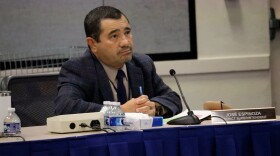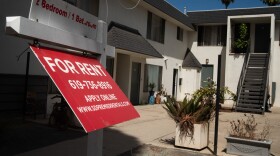Carl Luna has been observing political engagement in the San Diego region since the 1990s.
He said the crowds that showed up for the local portion of what organizers called Saturday’s nationwide "No Kings" protests were “unprecedented.”
“You had numerous events across the county, from Escondido down to the waterfront in San Diego. And in the city of San Diego you had the largest protest crowd I think that we've ever seen,” said Luna, who is director of the University of San Diego’s Institute for Civil Civic Engagement.
Take Action San Diego was one of the groups that organized the protest. Larry Stowell is a volunteer with the group and was in charge of tracking the crowd’s size.
Their crowd estimate on the day of the march was more than 60,000. Stowell said it came from a method, which looks at the density of people in one section of a protest, and multiplies that over the whole crowd. It’s called the Jacobs Crowd Formula.
The newly updated estimate of roughly 69,000 protestors uses a method that’s a little more high-tech — combining aerial news footage with on-the-ground video from the group’s own stationary cell phone.
“And those two combined give us the ability to get a reliable and pretty good estimate of the crowd that's at a march,” Stowell said.
The data for the group’s findings are being shared on the Take Action San Diego website.
“We use open source methodology and reproducible research. So if there's some computer code that helps out, we provide the code,” Stowell said. “And we’ll have all the raw data we collected, so if someone else wants to analyze the data also.”
The San Diego Police Department used the original number of 60,000 plus participants in their statements about the protest. They said they got it from the organizers.
“The 60,000 was on the low end. They had numbers that went up all the way to 80,000,” said San Diego Police Department Lt. Travis Easter.
He said SDPD does not track protest crowd sizes independently.
“At the time when those events are happening we’re focused on keeping everybody safe: traffic control, making sure it's peaceful, lawful,” Easter said.
Luna said San Diego is normally a town where it's challenging to politically activate the masses.
“For a politically focused protest, this was the biggest in our history. And that's significant — it means San Diegans are really motivated on this particular set of issues,” he said.
Luna said the next largest political protest in San Diego was the 2017 Women's March, where over 30,000 people showed up.
“You can go back to the George Floyd protests — those tended to be sporadic and in the hundreds to low thousands. You go back to the civil rights movement — Martin Luther King Jr. came here to talk in the 1960s — those crowds were in the hundreds to low thousands,” he said.
Luna believes last Saturday’s turnout was so high because people feel disenfranchised and helpless.
“When you get that many people together you realize you are not alone and now you can start focusing on more coordinated action to affect politics and policy,” he said.





